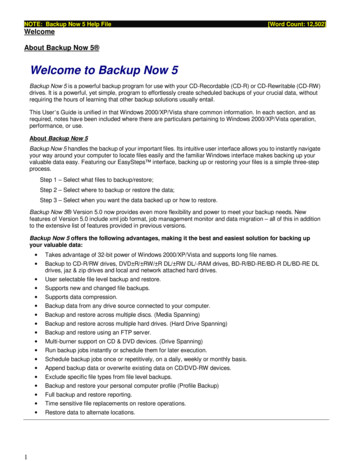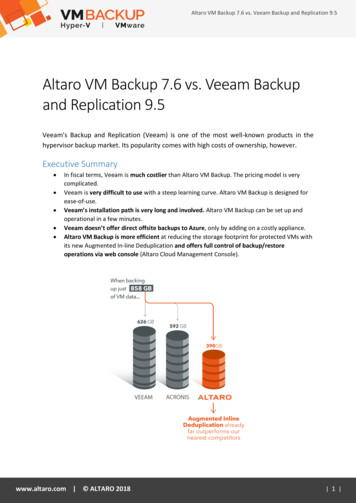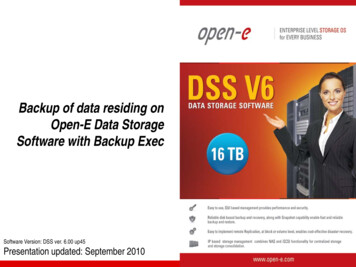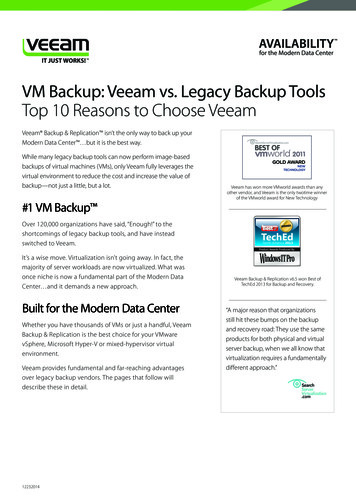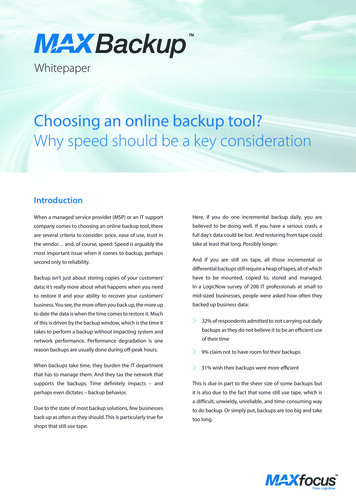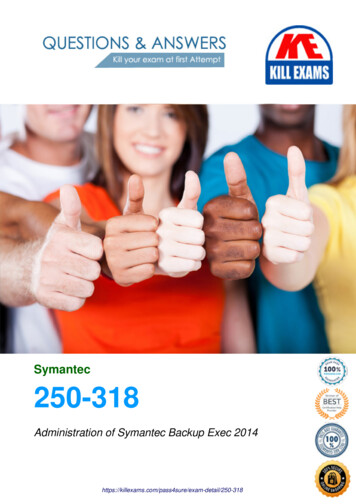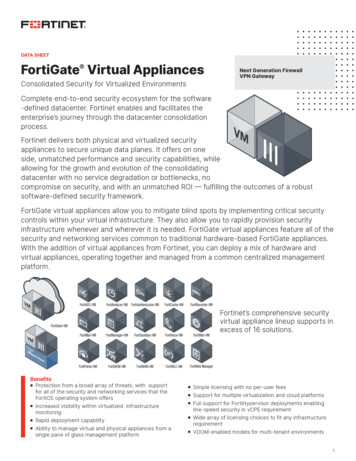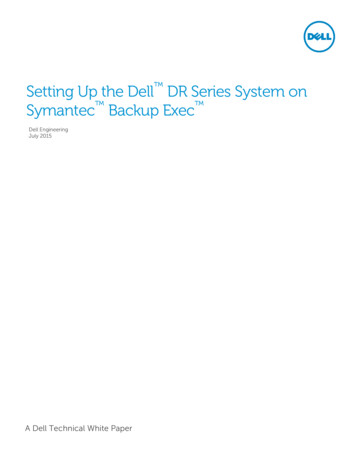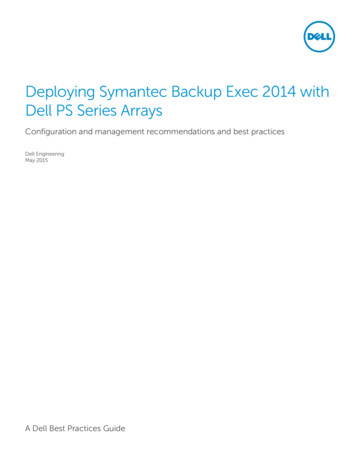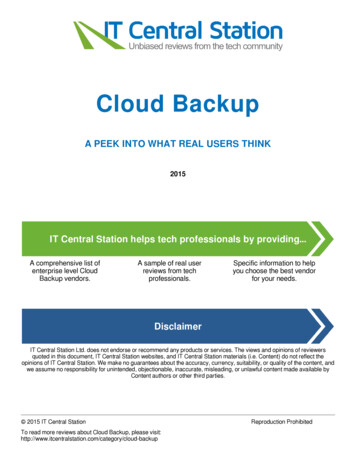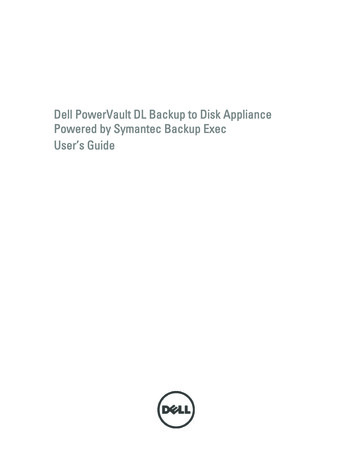
Transcription
The Insider’s Guide to EvaluatingIntegrated Backup Appliance Solutions2014-15INTEGRATED BACKUPAPPLIANCEBUYER’S GUIDEBy Charley McMaster and Jerome WendtE M P O W E R I N G T H E I T I N D U S T R Y W I T H A C T I O N A B L E A N A LY S I S · W W W. D C I G . C O M
2014-15 INTEGRATED BACKUP APPLIANCE BUYER’S GUIDEThe Insider’s Guide to Evaluating Integrated Backup Appliance SolutionsTable of Contents1Introduction3Executive Summary5How to Use this Buyer’s Guide6Disclosures6Inclusion and Exclusion Criteria7The 8-Step Process Used to Score andRank Integrated Backup Appliances8Comments & Thoughts on 23Barracuda Backup 19061Simpaticorp DRXpress24Barracuda Backup 39062STORServer BA601-CV25Barracuda Backup 49063STORServer BA601-TSM26Barracuda Backup 69064STORServer BA701-TSM27Barracuda Backup 89065STORServer EBA801-CV28Barracuda Backup 99066STORServer EBA802-TSM29Barracuda Backup 109067STORServer EBA1202-CV30Dell DL4000 High Capacity68STORServer EBA1202-TSM31Dell DL4000 Standard69STORServer EBA2202-CV32EMC Avamar DataStor 1.3TB70STORServer EBA2202-TSM33EMC Avamar DataStor 2.6TB71STORServer EBA3202-TSM34EMC Avamar DataStor 3.9TB72Symantec BackupExec 360035EMC Avamar DataStor 7.8TB73Symantec NetBackup 523036EVault PnP100t 7G74Unitrends Recovery 17237EVault PnP300 7G75Unitrends Recovery 31238EVault PnP600 7G76Unitrends Recovery 313Integrated Backup Appliances8Auto-Tiering—SATA, SSD andPublic Storage Clouds8Metering39EVault PnP1200 7G77Unitrends Recovery 712Recovery Types and Guarantees40EVault PnP2400 7G78Unitrends Recovery 713MSPs (Managed Service Providers)41EVault PnP3800 7G79Unitrends Recovery 813De-emphasizing Cloud Connectivity42Eversync 100080Unitrends Recovery 82243Eversync 150081Unitrends Recovery 82344Eversync 200082Unitrends Recovery 82445Eversync 270083Unitrends Recovery 83346Eversync 450084Unitrends Recovery 86347Eversync 950085Unitrends Recovery 94348ioSafe 21486WD Arkeia DA130049Quorum onQ T2087WD Arkeia DA230050Quorum onQ 140-588WD Arkeia RA430051Quorum onQ 260-1389WD Arkeia RA530052Quorum onQ 280-1390WD Arkeia RA630053Quorum onQ 288-209154RackTop EBR-500Zenith InfotechBDR-4116-G12R1-R55RackTop Local EBR-10009256RackTop Local EBR-1800Zenith InfotechBDR-4216-G12R1-R57RackTop Local EBR-28009358RackTop EBR-FEZenith InfotechBDR-8432 G12R1-R59Simpaticorp DR49460Simpaticorp DR4 EnterpriseZenith InfotechBDR-12932-G12R1-R9912Integrated Backup Appliance Models88922DCIG Observations & Recommendations9Best-in-Class Ranking10Recommended Ranking10Excellent Ranking10Good Ranking11Basic RankingIntegrated Backup ApplianceScores and Rankings13Overall Scores and Rankings16Hardware Scores and Rankings19Software Scores and Rankings95Product Rankings DashboardAppendicesA-1 Appendix A—Definitions, Explanations and TerminologyB-1 Appendix B—Storage Provider Contact InformationC-1 Appendix C—Author Contact Information 2014 DCIG, LLC. All rights reserved. Licensed to STORServer Inc. with unlimited and unrestricted distribution rights.i
2014-15 INTEGRATED BACKUP APPLIANCE BUYER’S GUIDEThe Insider’s Guide to Evaluating Integrated Backup Appliance SolutionsIntroductionThe DCIG 2014-15 Integrated Backup Appliance Buyer’s Guide provides organizationsthe unique opportunity to review and evaluate the large number of backup appliances thatrepresent more steps forward in the continuing effort to simplify backup in today’s real-worldIT environments. By providers integrating the core components needed to deliver backup in asingle box, more of these appliances come closer to achieving the “plug and play” ideal thatenterprises seek.Integrated backup appliances have already been proven successful. But as this latestgeneration of appliances illustrate, organizations can expect an even better experience frombackup appliances going forward. More deduplication options, heightened support for virtualized environments, new alliances between hardware and software providers and increasedemphasis on providing more tightly integrated support from a single provider are just some ofthe new features that these appliances boast.Other areas where organizations will also see changes in backup appliances from the previous DCIG 2012 Backup Appliance Buyer’s Guide include: Backup appliances make better use of solid state drives (SSDs) which contribute toincreases in throughput and performance. Large providers like Dell have shed its alliances with traditional backup software providerssuch as CommVault and Symantec in favor of creating its own line integrated backupappliances that only use Dell hardware and software. Shunned by Dell, Symantec and CommVault have adapted to this new world of backupappliances. Symantec now develops and markets its own line of appliances while in thelast quarter of 2013 CommVault aligned with STORServer, the winner of the previousDCIG 2012 Backup Appliance, to create a compelling new line of backup appliances.One key differentiator witnessed in the research for this Buyer’s Guide is that providersare strengthening their offerings with services. As organizational needs increase, providers are bulking up their support and technology support teams to meet their heightenedexpectations for faster response times and quicker resolutions to the challenges they face.In a recent press release, IDC noted that “appliance-based protection and recovery hastaken root in customers' environments as a simplified approach to meet their backup andrecovery challenges.”1Another intriguing shift in customer support is that a few providers such as STORServer arerolling out data recovery guarantees. A data recovery guarantee is a major commitment tomake, but is important for those who purchase an appliance. Depending on the appliance,data may be able to be retrieved from the cloud, from the appliance itself, or may simplymean the appliance can perform data recovery in a certain amount of time. Based on thehighly competitive nature of this market, it is logical to conclude that other providers will soonfeel the pressure to offer a feature like this in the not too distant future.The growth of integrated backup appliances has led organizations to choose appliancesthat better align with where they want to store their data – be it in private clouds, publicclouds or some combination of both (hybrid clouds.) It is because of this fragmentation thatDCIG now segments backup appliances between those intended for use in private clouds,1. IDC, "Worldwide Purpose-Built Backup Appliance (PBBA) Market Experiences Continued Growth in Second Quarter of 2013,According to IDC." Sept. 23, 2013. http://www.idc.com/getdoc.jsp?containerId prUS24334613. 2014 DCIG, LLC. All rights reserved. Licensed to STORServer Inc. with unlimited and unrestricted distribution rights.1
2014-15 INTEGRATED BACKUP APPLIANCE BUYER’S GUIDEThe Insider’s Guide to Evaluating Integrated Backup Appliance nued) such as are featured in this DCIG 2014-15 Integrated Backup Appliance Buyer’s Guide,and those that do hybrid backup which keep data both on premise and in public clouds.This type of backup appliance will be addressed in the upcoming DCIG Hybrid CloudBackup Appliance Buyer’s Guide, due out later in 2014. Currently DCIG has no plans toproduce a Buyer’s Guide on backup appliances or software that only store data in publicclouds or with public cloud providers.Integrated backup appliance challenges come mainly from other types of purpose-builtbackup appliances (PBBAs), including deduplicating backup appliances and deduplicationsoftware that can be run on regular backup servers. While deduplicating backup appliancesprimarily function as backup targets for existing backup software that organizations alreadyown, a number of these can optionally host backup software and be deployed as an allin-one solution. However since the integration between backup software and underlyingdeduplicating appliance is minimal at best, DCIG elected not to evaluate these solutions.This lack of integration also factored into DCIG’s decision to name this Buyer’s Guide theIntegrated Backup Appliance Buyer’s Guide as opposed to just using the term BackupAppliance Buyer’s Guide.Looking from top to bottom at the products included in this DCIG Buyer’s Guide, they sharerelatively similar software configurations between larger and smaller systems. Differentiationcomes more in how the appliance scale their hardware components and what hardwarefeatures are included on each model. However it is safe to conclude that the highest scoringand ranking models tend to have more robust features in all areas from hardware capabilitiesto support for virtualized environments to the backup software features they offer.One may also assume that higher-scoring appliances should perform better than lower scoring and ranking appliances, though this comes with some qualification. Their inclusion ofhigh-performance SSDs, robust deduplication features, greater amounts of cache and higherperformance network interfaces (10Gb Ethernet and/or 8Gb FC) should certainly help toaccelerate backup performance in most environments. However they are so many factors thatinfluence backup performance in any environment that DCIG encourages every organizationto test the appliance in its environment if at all possible to verify it will truly increase throughputand shorten backup windows.The appetite for implementing integrated backup appliances into organizations that do notalready own them, or do and will need to expand their lineup, looks promising. Indeed,providers like Barracuda saw a significant 31% growth in revenue during Q2 2013.2 If trendslike this continue, the integrated backup appliance market will continue to be one to watchin IT infrastructures for the foreseeable future.2. Barracuda Ranked Number One in Integrated Systems for Purpose-Built Backup Appliances,” Barracuda Networks pressrelease, October 09, 2013. PRWeb website. 2014 DCIG, LLC. All rights reserved. Licensed to STORServer Inc. with unlimited and unrestricted distribution rights.2
2014-15 INTEGRATED BACKUP APPLIANCE BUYER’S GUIDEThe Insider’s Guide to Evaluating Integrated Backup Appliance SolutionsExecutiveSummaryIntegrated backup appliances have spent the last few years illustrating that they are anotherstep in the evolution of data backup and recovery. Combining the reliability and familiarity ofphysical server hardware, the increased throughput that memory, SSDs and 10Gb Ethernetand/or FC networks provide, plus throwing in virtualization and deduplication capabilities forgood measure, integrated backup appliances make deploying and implementing backup inenterprise environments easier and faster than ever before.Data protection is an essential yet laborious and time-consuming task that every organization must perform. Organizations capture, store and retain more types of data for longerperiods of time than ever before. Identifying the right hardware and software, rounding upthe manpower to implement it and managing and supporting the solution over the longterm can tie up even the best IT teams. Integrated backup appliances address all of thesechallenges by providing a customizable, self-contained solution that are available in numerous form factors to give organizations the many choices they now need for the variousenvironments into which they are deployed.By offering such a simple, effective solution, integrated backup appliances have placedtheir finger directly on a problem organizations have dealt with for years and it shows. IDCrecently released a study saying integrated backup appliances experienced 7 percent yearover-year growth in 2013.1As integrated backup appliances have gained in popularity, providers are stepping up theirgame, coupling greater storage capacity and increased appliance performance with deepercustomer support and broader data recovery guarantees. The result is an all-in-one dataprotection service that eliminates the need for organizations to build their own backup solutions using a myriad of hardware, software, and providers. But integrated backup appliancesare not just getting more robust, they are becoming easier to use, too.Integrated backup appliances may never be fully “plug and play,” but they are comingmuch closer to the “plug it in, turn it on, and it’s good to go” ideal that organizations want.These appliances offer backup software bundled with the needed hardware along with themanagement capabilities to quickly put in place backup and restore policies in an enterpriseenvironment.When looking through this Buyer’s Guide, it is easy to be overwhelmed by the many optionsavailable. To help prioritize their choices, prospective buyers should ask themselves thefollowing questions: Are fast backups a necessity? Does the organization have a highly virtualized environment? Are multiple types of deduplication necessary? How much data is there to backup? Is this appliance going into a remote or branch office? Is quick recovery time a high priority? Is there a need to replicate data off-site to one or more locations?1. IDC, “Worldwide Purpose-Built Backup Appliance Market Experiences Continued Growth in Second Quarter of 2013,According to IDC.” 23 Sept. 2013. http://www.idc.com/getdoc.jsp?containerId prUS24334613. 2014 DCIG, LLC. All rights reserved. Licensed to STORServer Inc. with unlimited and unrestricted distribution rights.3
2014-15 INTEGRATED BACKUP APPLIANCE BUYER’S GUIDEThe Insider’s Guide to Evaluating Integrated Backup Appliance SolutionsExecutive Summary(continued)Executive SummaryAnswers to these questions will influence which backup appliance is the best choice for your(continued)environment. However the integrated backup appliances with the highest scores and rankings in this Guide are likely to be the best answer to these questions.As will be clear, many of the appliances contained herein have improved exponentially incapabilities when compared with just two years ago, when DCIG published this Guide’spredecessor.The DCIG 2014-15 Integrated Backup Appliance Buyer’s Guide is designed to cut timeand cost from the product research process. DCIG invested hundreds of hours designing asurvey that captures the data most relevant to prospective backup appliance purchasers,analyzing the results and then reporting on its findings.While compiling this Buyer’s Guide, DCIG spoke to various end-users to get a sense of howthey would weight their needs in various areas. DCIG then evaluated each vendor’s capabilities by applying a weighting to these features based upon our conversations with theseend-users and our experience.It is in this context that DCIG presents its 2014-15 Integrated Backup Appliance Buyer’sGuide. As prior Buyer’s Guides have done, it puts at the fingertips of organizations acomprehensive list of integrated backup solutions and the features they offer in the form ofdetailed, standardized data sheets that can assist them in this important buying decision.This Buyer’s Guide is the result of a multi-month effort that involved communicating withmultiple providers and evaluating over 80 features on 72 different integrated backup solutions. Each provider was given the opportunity to complete a survey with over 85 questionsthat examined how its solution delivered on features associated with management, hardware, scalability and support.In instances where vendors did not respond, DCIG completed the surveys on the vendor’sbehalf and then sent the completed survey to the vendor for their review. In every case,every vendor had the opportunity to review and respond to the survey and the informationregarding the product displayed on its data sheets included in this Buyer’s Guide.This DCIG 2014-15 Integrated Backup Appliance Library Buyer's Guide accomplishesthe following objectives: Provides an objective, third party evaluation of integrated backup appliances thatweights, scores and ranks their features from an end user’s viewpoint Includes recommendations on how to best use this Buyer’s Guide Scores and ranks the features on each integrated backup appliance based upon criteriathat matter most to end users so they can quickly know which products are the mostappropriate for them to use and under what conditions Provides data sheets for 72 integrated backup appliances from 14 different providersso organizations can do quick comparisons of the features that are supported and notsupported on each product Provides insight into which features integrated backup appliances offer Gives any organization the ability to request competitive bids from different providersof integrated backup appliances that are apples-to-apples comparisons 2014 DCIG, LLC. All rights reserved. Licensed to STORServer Inc. with unlimited and unrestricted distribution rights.4
2014-15 INTEGRATED BACKUP APPLIANCE BUYER’S GUIDEThe Insider’s Guide to Evaluating Integrated Backup Appliance SolutionsHow to Use this Buyer’s GuideIn determining how to best use the information containedin this DCIG 2014-15 Integrated Backup Appliance Buyer’sGuide, it is important to note that it is intended to helpusers in their purchase of an integrated backup appliance.The purpose of this Buyer’s Guide is NOT to tell usersexactly which integrated backup appliance to purchase.Rather, it is to help guide them in coming up with a list ofcompetitive products that have comparable features thatmeet their specific needs.It is also important to note that just because a productscored higher than another, achieved the highest in aparticular category or is ranked a certain way, that does notautomatically make it the right product or fit for an organization. If anything, because of the scope of the integratedbackup appliance models evaluated and analyzed, somecould have features that are too robust for the needs of anindividual department or organization.However, what this Buyer’s Guide does is give users somesense of how each appliance compares to other integratedbackup appliances, as well as offer substantial insight intowhat product offerings are available on the market.DCIG recommends that you use this DCIG 2014-15Integrated Backup Appliance Buyer’s Guide in thefollowing seven ways. Eliminate the painstaking research associated withcoming up with a short list of integrated backupappliances that meet your needs. This Buyer’s Guideranks, scores and contains data sheets for 72 differentmodels from 14 different integrated backup applianceproviders. Each integrated backup appliance is scoredand then ranked as Best-in-Class, Recommended,Excellent, Good and Basic based upon its overall score.On each appliance, over 100 different features wereevaluated, weighted, scored and then ranked. Using thisguide, an organization may only have to look at thescores and features of each product in order to come upwith a short list of products for consideration. Do apples-to-apples comparisons of integratedbackup appliances from different providers.Getting competitive bids from multiple providers is smartbusiness. After all, when they compete, you win! But thattactic only works when organizations know they arereceiving competitive bids on products that are roughlycomparable. By using this DCIG 2014-15 IntegratedBackup Appliance Buyer’s Guide, organizations can do abetter job of accomplishing that objective. Separate the apples from the oranges. Just asimportant as doing apples-to-apples comparisons isidentifying when an orange is thrown into the mix. It canbe difficult for an organization to know if it is truly gettinga good deal when bids come in from multiple providerswith different models. Now, an organization can refer tothe scores and rankings of each integrated backupappliance in this guide so it can know when it is gettinga good deal, a great deal or just a so-so one by identifying those models which are substantially alike and whichones have significantly more (or less) capabilities. Provides perspective on how models from lesswell-known providers compare against establishedbrands. Anyone involved with integrated backupappliances at all has probably heard of providers such asBarracuda and Dell. This creates a certain built-incomfort level when buying products from these companies and a corresponding built-in resistance to buyingintegrated backup appliances from companies that maybe perceived as unknown quantities. This Buyer’s Guide helps to remove some of thatapprehension about buying from a lesser-knownprovider or even a lesser-known model from anestablished provider. By using this Buyer’s Guide,organizations can see how these models from lessfamiliar companies—as well as unfamiliar models fromestablished providers—stack up. Normalizes complex backup appliance terminology. Every computing industry has a proclivity to adoptacronyms and jargon that is specific to it, but theintegrated backup appliance industry seems to takespecial pains not only to use unfamiliar terms, but also torefer to the same technology in different ways. ThisBuyer’s Guide aims to normalize the acronyms andjargons, eliminating the need for users to fully understandthe industry’s terminology. Creates a standardized data sheet. The productdata sheets available from different providers are rarelylaid out in the same way or contain the same information.Some providers even have data sheet formats that varyfrom model to model within their own product portfolio. 2014 DCIG, LLC. All rights reserved. Licensed to STORServer Inc. with unlimited and unrestricted distribution rights.5
2014-15 INTEGRATED BACKUP APPLIANCE BUYER’S GUIDEThe Insider’s Guide to Evaluating Integrated Backup Appliance SolutionsThis Buyer’s Guide tackles this problem by creating astandard, easy-to-read data sheet for every integratedbackup appliance. In this way, data sheets for individualproducts can be printed out and laid down side-by-sidefor quick comparison. Helps justify technical buying recommendationsto business folks. Nothing is easier for those on thebusiness side to understand than a number when doingcomparisons. With this in mind, DCIG includes productand category scores at the top of each data sheet sothe business side of the house can quickly comparedifferent models.DisclosuresOver the last few years the general trend in the US hasbeen for both large and boutique analyst firms to receivesome or all of their revenue from integrated backup appliance providers.DCIG is similar in that it also receives payment for the different services it performs for some integrated backup appliance providers. The services that DCIG provides includeblogging, case studies, product reviews, executive whitepapers, special reports and white papers.In the interest of being transparent: some of the providersincluded in this DCIG 2014-15 Integrated Backup ApplianceBuyer’s Guide are or have been DCIG clients. This is notto imply that they were given preferential treatment in theBuyer’s Guide. All it means is that DCIG may have had moreknowledge of their integrated backup appliances and thatDCIG would consider their products for inclusion in thisBuyer’s Guide. All research was based upon publicly available information, information provided by the storage provider, andthe expertise of those evaluating the information. Because of the number of features analyzed, how thesefeatures were weighted and then how the integratedbackup appliance models were scored and ranked, therewas no way for DCIG to predict at the outset how anindividual integrated backup appliance model wouldscore or rank. DCIG wants to emphasize that no provider was privy tohow DCIG did the scoring and ranking of the integratedbackup appliances. In every case, the providers onlyfound out the scores and rankings of their model(s) afterthe analysis was complete.Inclusion and Exclusion CriteriaThis DCIG 2014-15 Integrated Backup Appliance Buyer’sGuide has incorporated input from key users and providersinto defining the criteria used to decide what backup appliances belonged or did not belong in this Buyer’s Guide. ThisBuyer’s Guide attempts to take into consideration as manyof these variables as possible, but likely failed to account forall of them. While this may have resulted in a specific modelnot being covered in this Buyer’s Guide when it rightfullymay have belonged, DCIG believes the following criteria wasconsistently applied as we did our research and made ourdecisions.The rationale that was used to determine the inclusion andexclusion of specific models in this Buyer’s Guide is as follows:The focus of this survey is to evaluate integrated backupappliance solutions that meet the following requirements:In that vein, there are a number of important facts to keepin mind when considering the information contained in thisDCIG 2014-15 Integrated Backup Appliance Buyer’s Guideand its merit. Be available as a physical appliance that includesbackup software as a combined bundle under on SKU. No provider paid DCIG any fee to develop this Buyer’sGuide. Store data on premise on DAS, NAS orSAN-attached storage. This is not to imply that theappliance could not connect to a public storage cloud.In fact, DCIG found that in defining the basic characteristics of a backup appliance, these systems oftenincluded this option as part of its bundled offering. DCIG did not guarantee any provider that its productsand/or services would be included in this Buyer’s Guide. DCIG did not imply or guarantee that a specific integrated backup appliance model would receive a goodscore on this Buyer’s Guide ahead of time. May ship as a virtual appliance. Includes backup software. 2014 DCIG, LLC. All rights reserved. Licensed to STORServer Inc. with unlimited and unrestricted distribution rights.6
2014-15 INTEGRATED BACKUP APPLIANCE BUYER’S GUIDEThe Insider’s Guide to Evaluating Integrated Backup Appliance Solutions Sufficient information provided to reach meaningful conclusions. DCIG made a good faith effort toreach out and obtain information from as many backupappliance providers as possible by providing surveys tothem for them to complete. However in a few casesbackup appliance models still had to be excludedbecause of a lack of reliable data. Must be GA by January 1, 2014. A cut-off date hadto be put in place or this Buyer’s Guide would never bepublished. Some allowances were made for feature orproduct enhancements that were made in late 2013 thatdid not adversely affect the analysis done in developingthis Buyer’s Guide.The 8-Step Process Used to Score andRank Integrated Backup AppliancesTo score and rank each integrated backup appliance, DCIGwent through an eight-step process to come to the mostobjective conclusion possible.1. DCIG listed out all of the features available onintegrated backup appliances. Prior to selecting thefeatures that were included in the final evaluation in theBuyer’s Guide, DCIG went through and quantifiedwhat features integrated backup appliances possess.As part of this process, DCIG normalized the list offeatures available on an infrastructure to establish acommon name for each feature.2. DCIG established which features would beincluded in the Buyer’s Guide and which oneswould not. One of the goals of this Buyer’s Guide wasto try to only include features on each integrated backupappliance model that could be objectively and authoritatively analyzed.3. Each feature had a weighting associated with it.The weightings were used to reflect if a feature wassupported and potentially how well it was implemented.As such, features were weighted and scored differently.4. A survey covering the features scored in thisBuyer’s Guide was sent to each provider. Inaddition to using the information that was publiclyavailable on each integrated backup appliance provider’s website, each provider had the opportunity torespond to a survey from DCIG. This was done to bothverify that the information DCIG found on the provider’swebsite was correct, as well as remove any ambiguitiesthat existed regarding how some of the features wereimplemented.5. All vendors were given the opportunity to reviewtheir data sheets before the final scores andrankings were determined. To ensure the informationpresented in this Buyer’s Guide is as up-to-date andreliable as possible, DCIG provided each vendor with acopy or copies of their respective data sheets thatappear in this Buyer’s Guide without the scores andrankings on them. In this way, they had the opportunityto validate the information and potentially correct itbefore it was publicly released. In cases where DCIGreceived no information at all from the vendor, it made anotation at the bottom of that vendor’s data sheet(s) toindicate all information was gathered from publicallyavailable sources and the analyst’s own expertise andknowledge of the product.6. All of the features were scored based upon theinformation presented in this Buyer’s Guide. Theweighting and scoring of the integrated backupappliances found in this Buyer’s Guide was done byDCIG based on past experience with other Buyer’sGuides and input from end users. Only features that arepresented in this Buyer’s Guide were used to arrive atthe final scores and rankings for each product.7. The features were broken down into four generalcategories. The features included in this Buyer’s Guidebroke down into a total of four broad categories that arereflected on each integrated backup appliance datasheet. These four categories are Hardware, Software,Support, and Virtualization.8. The integrated backup appliances were rankedusing standard scoring techniques. One of thegoals of this Buyer’s Guide is to establish clear lines ofdifferentiation between integrated backup applianceswith conclusions that are arrived at objectively. Toaccomplish this goal, the mean or average score foreach classification was first determined and then thestandard deviation.9. Using the mean of the scores from all of the integratedbackup appliances from which the standard deviationwas calculated, DCIG developed a ran
Introduction (continued) such as are featured in this DCIG 2014-15 Integrated Backup Appliance Buyer's Guide, and those that do hybrid backup which keep data both on premise and in public clouds. This type of backup appliance will be addressed in the upcoming DCIG Hybrid Cloud Backup Appliance Buyer's Guide, due out later in 2014. Currently .
